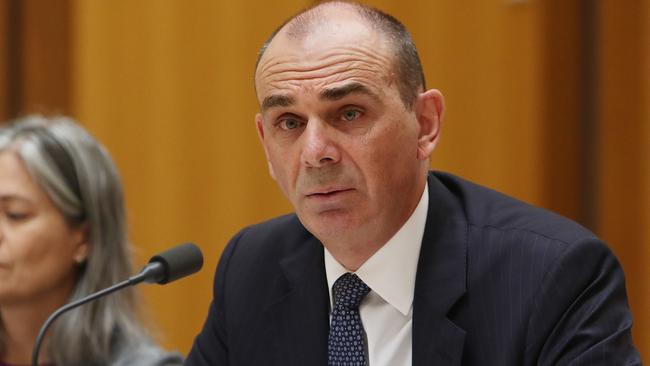
The Australian Prudential Regulation Authority’s co-ordinated capital charges on ANZ, Westpac and National Australia Bank follow the $1 billion additional capital impost on Commonwealth Bank last year.
Governance and operational risk failings are at the heart of the charges.
NAB is, though, not a stranger to this sort of APRA action. It faced capital charges after the massive fallout that accompanied the 2004 foreign exchange scandal and associated trading losses.
Obviously, those operational risk and compliance learnings weren’t retained, despite APRA lifting the capital impost two years later.
NAB was hit with an additional 100-basis-point common-equity tier-one capital charge following a 2004 APRA probe into the trading events. That took NAB’s total capital to 10 per cent of risk-weighted assets.
At the time, a report by APRA said: “That this was possible was, first and foremost, due to the collusive behaviour of the traders themselves. However, it can also be attributed to an operating environment characterised by lax and unquestioning oversight by line management; poor adherence to risk management systems and controls; and weaknesses in internal governance procedures.”
Sounds like some of the same failings we heard about too often at the Hayne royal commission, and read in NAB’s latest self-assessment submitted to APRA.
The ramifications in 2004 were wide-ranging, as the trading scandal led to the axing of chief executive Frank Cicutto and chairman Charles Allen as part of a board clean-out. At least one of the traders involved spent time in jail.
But banks seem to rectify issues to keep regulators at bay and then fall into the same trap of getting complacent on governance and risk.
NAB’s latest self assessment — submitted in November — proves this point. “NAB’s approach to compliance has lacked rigour and discipline, and the voice of the compliance function has been too weak,” it said.
NAB made public its self-assessment late last year and Westpac followed yesterday.
The irony in Westpac’s report, at 128 pages, is that it ignored its own advice that too often employees and managers were layering on more and more information that added to complexity rather than being efficient.
At 128 pages, the more is better approach certainly came through.
“There is a tendency towards ‘completeness’, which can lead to acceptance and perpetuation of organisational complexity,” the Westpac report said. “Group audit has at times not exerted sufficient influence on matters of concern, and it can on occasion intensify focus on certain issues only after regulator attention: it may also benefit from additional expertise in some fields, and is investing in 2019 to that end.”
In contrast, NAB kept its assessment to 62 pages.
ANZ is now the outlier in failing to allow public scrutiny of its self-assessment.
A fund manager contacted by this column labelled the latest round of capital charges a light- handed approach by APRA, given the amounts involved. Either way, the regulator has signalled it is closely watching to see how banks implement their operational risk laundry lists.
One hopes the royal commission learnings stick.
ANZ’s rates move
APRA’s removal of the 7 per cent interest rate threshold for banks when they make home loan serviceability assessments has already prompted changes through the market. The banks added another 25 basis points to that for good measure.
ANZ is the latest to make a revision on the back of APRA’s change.
This column understands the bank has told mortgage brokers that, from July 15, instead of baking in a 7.25 per cent interest rate threshold, the level will drop to 5.5 per cent.
That will provide a boost to those seeking to borrow more or customers who struggled to get a mortgage approved under the outdated 7.25 per cent level. Given the official cash rate is at 1 per cent and competitive mortgage rates are generally in the 3 per cent range, the APRA threshold was overly conservative.
On the home loan buffer, which is the other measure APRA wants banks to use, ANZ will follow the regulator’s guidance and increase that to 2.5 per cent, from 2.25 per cent.
The buffer is added to the loan’s interest rate to ensure a customer can keep up with payments during periods of higher rates.
That means from next week in its loan assessments ANZ will use the higher of the 2.5 per cent plus the mortgage rate, or the 5.5 per cent threshold.
Man or machine
OFX chief Skander Malcolm sums up the finance sector’s woes in one sentence: “In financial services, trust is the biggest pain point.”
His solution is an interesting one, particularly as the big banks figure out the best balance between the shift to digital and maintaining a branch presence.
Foreign exchange and payments companies like OFX are also navigating a shifting regulatory landscape and the threat of new players.
Malcolm believes the best way forward for finance companies and their customers is a combination of human and digital interaction. He cites Forrester Consulting and marketing group Braze research that found consumers were 1.8 times more likely to recommend brands seen as more “human”.
“Trust is the issue here. You don’t get trust from a truly digital method,” Malcolm said.




The banking regulator’s unprecedented decision to slap $500 million capital charges on three of the big four is further evidence the banks haven’t learnt past lessons.